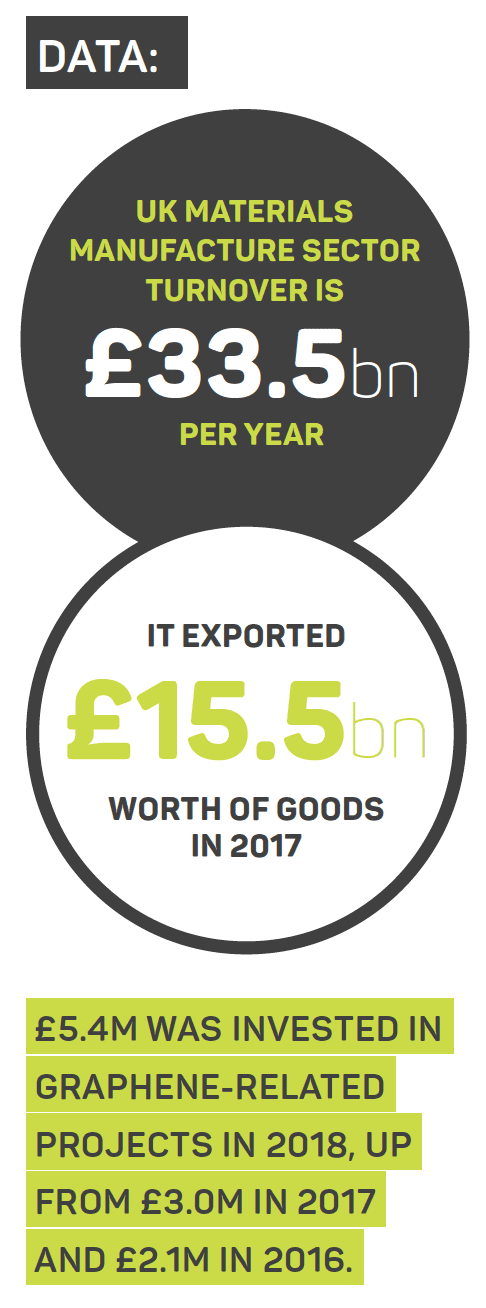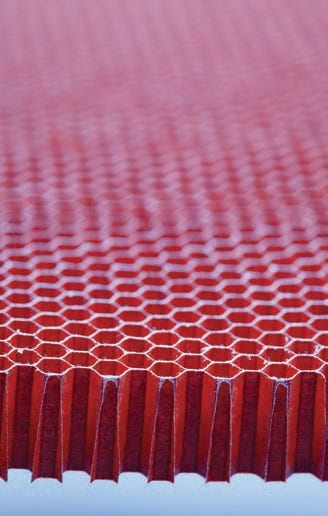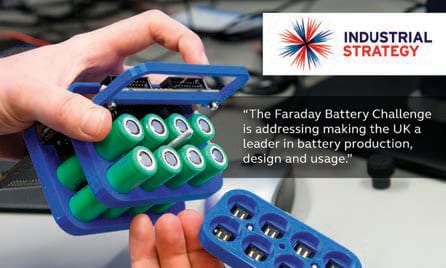THE MANUFACTURING SECTOR IS INHERENTLY BOUND UP WITH THE MATERIALS SECTOR. THIS IS REFLECTED IN THE STRATEGIES MANY COUNTRIES HAVE FOR BOTH INDUSTRIES, WHICH OFTEN JOIN THE TWO AND ENSURE THAT THEY FEED INTO EACH OTHER IN A VIRTUOUS CIRCLE.

Dr Lien Ngo, Innovation Lead – Advanced Materials, Innovate UK
2018 has been a very important year for materials and manufacturing. In March, Innovate UK repeated a major event called the The Materials Research Exchange (MRE) which brought together over 1300 people, 70 exhibitors and 89 speakers from within the materials community, academics, businesses and research organisations. The event aimed to connect the materials-related communities: materials users with providers, innovators with investors, researchers with applications designers. It was the first such large gathering of the materials community since the inaugural MRE in Coventry in 2014. If you missed it, look out for the next one in 2020.
MRE 2018 launched the Materials Landscape Study, commissioned by Innovate UK and the Department for Business, Energy and Industrial Strategy (BEIS). This groundbreaking survey of the UK’s industrial materials cohort gives a tremendous insight into the scale and competitiveness of the sector. It has always been a challenge to find good, publicly-available data on the materials industry. We know that it is a key enabling technology and so is counted in lots of sectors. What makes this study groundbreaking is that it takes a bottom up methodology, identifying and counting the businesses (and identifying materials-related portions of bigger companies) working in the materials space and forming a picture of the industrial landscape that way.
High value operations

Materials research Exchange 2018 attracted over 1300 attendees, 70 exhibitors and 89 speakers.
This showed that the turnover of the materials manufacture sector in the UK is £33.5bn per year, comparable to the aerospace sector at £31.1bn. This reinforces what we already know- that materials is a huge industry in the UK and contributes massively to its economic wealth. It exported £15.5bn worth of goods in 2017. The market study also finds, unsurprisingly, that growth rates of all materials are linked to the growth of their main application sectors, such as transport and healthcare, but that emerging materials are predicted to have much higher growth than traditional materials sectors. This is good news for the UK, which is excellent at discovering new materials and has a healthy community of start-ups and SMEs working to commercialise them.
The report also breaks down companies working in different classes of materials and gives a geographic mapping. This shows materials to be a crucial part of a much-desired balanced economy, with the largest number of companies and the most value generated in the West Midlands, with significant contribution from the North West and North East. The report and full database are available on the KTN website.
Fighting plastic waste
This year saw a focus on supporting innovation in plastics and packaging. Growing concerns about the impact of plastic waste on the environment highlighted by a number of high-profile campaigns were recognised by the creation of the Plastics Research and Innovation Fund. This programme will support a wide range of cross-cutting academic research programmes, from developing a better understanding of the impact of plastics in the marine environment to cutting edge research into novel recycling approaches. Commercial R&D projects are also being funded, ranging from developing edible-packaging materials to addressing the challenge of using increased quantities of recycled polymer into high-end applications like roto-moulding.
This year also saw the opening of the Sir Henry Royce Institute for Advanced Materials, one of the biggest recent investments in materials research and innovation. It operates as a cluster of academic expertise around the country with a hub at the University of Manchester. It looks to collaborate with industry, bringing world-leading researchers and companies together.
The UK is excellent at discovering new materials and has a healthy community of start-ups and SMEs working to commercialise them.

Graphene: solutions in search of applications
We can’t speak of Manchester without mentioning one of its home-grown academic successes. At Innovate UK, we’ve supported graphene companies and their development to the tune of over £33m. We have run two graphene-specific competitions and since then, companies exploiting graphene have taken this boost and run with it. Without any specifically earmarked money, graphene projects have grabbed an ever-larger amount of innovation funding. In 2018, we invested £5.4m in graphene-related projects, up from £3.0m in 2017 and £2.1m in 2016.

Three or four years ago, the chicken-and-egg problem was “we don’t know what kind of graphene to manufacture until there is an application; but we don’t know what applications are realistic until we know what kind of graphene can be made at scale”. This has changed subtly in the last year or so. Now it is generally accepted that that the graphene market is demand-limited. Many graphene forms can be manufactured at scale or by methods which are realistically scalable, so the race is on for applications.
To help companies trying to exploit the properties of graphene, this year Innovate UK and the British Standards Institute published a Publicly Accessible Specification, PAS 1201, which suggests information that manufacturers and producers can include with their products so that buyers and users of graphene can compare some basic baseline properties from different batches and suppliers. This joins efforts from the National Physical Laboratory and the National Graphene Centre in leadership in definitions, standards and characterization of graphene and 2D materials.
The race towards applications is reflected in the graphene projects Innovate UK have supported in the last year or so: they have really shown a step change in sophistication and movement up the TRL scale. I’ve been impressed with not only the technical results of projects but also the attention paid to processing and scale-up.
Advancing composites

Honeycomb structure of Kevlar, still a favourite in composite material construction.
One of this year’s success stories is Versarian’s collaboration with AXIA Materials, a partner they met as part of an Innovate UK mission to South Korea. The collaboration aims to develop graphene enhanced composite materials and smart graphene devices, using Versarian’s graphene nanoplatelets and inks. From that successful mission, we expect more collaborations and partnerships with South Korean companies and tech organisations next year, with an announced £4m funding for bilateral projects.
An expert mission in composites and composite manufacturing also spent a week in the USA meeting academics, research organisations and companies, looking for ways to collaborate. We are looking to step up international activities in materials next year.
Next year, we also expect more materials opportunities in the Industrial Strategy Challenge Fund areas. The government’s Industrial Strategy is an unprecedented opportunity for the materials community to highlight how it enables new technology and increases productivity. There are as many ways to do this as there are new and exploitable materials, but we should keep in mind two major approaches on how best to take advantage of this opportunity.
Challenging conventions
One is the obvious materials-specific Challenges. The other is that, as a key enabling technology for almost all market sectors, materials innovation fits into sector activities and we should be looking at every Challenge to see where materials can contribute. This is easier for some, such as the Faraday Battery Challenge or Robotics for Extreme Environments from the first wave of challenges, but there will be good opportunities in the second wave and from April next year in the third wave of challenges.
Already the Budget earlier this year announced challenges in Quantum, Made Smarter and Stephenson, last week the Future Flight challenge was announced as part of the Aerospace sector deal. Do keep your sights on our website for announcements of funding competitions related to the Industrial Strategy.
As we look ahead even further, the Advanced Materials team at Innovate UK are working to build communities in metamaterials and metal-organic frameworks, helping them to develop research into commercial products, like catalysts and sensors. We’re also continuing our collaboration with the Hartree Centre on an Internet of Materials- AI-enabled materials research which will radically speed up the process of both developing new materials and integrating them into the manufacturing supply chains.





